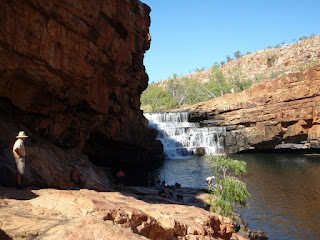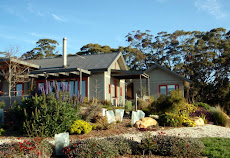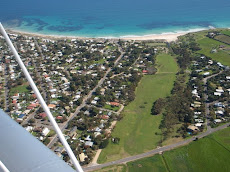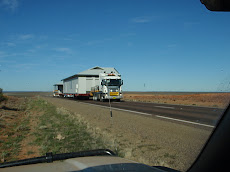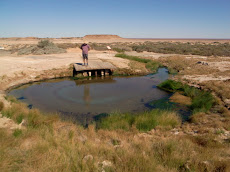I’m really impressed the way toilet roll is provided in campsites everywhere we go. One of the things you learn when travelling like this is how to manage paper that comes off a great roll, without those tear off bits. Trap the paper between the first and second fingers, then spool the paper around the hand. This accounts for the pathetically thin gauge it comes in, and ensures a level of satisfaction where these delicate matters are concerned. Toileting is something we gave a lot of thought to, and we even purchased a special tent for the purpose. So far we have had no need of it, facilities have been so good.
We have been lolling in fresh water pools for a long while now, but today we arrived beside the sea at Middle Lago on, half way up the Ardi - Dampier peninsula, on the way to Cape Leveque. Driving 110kms south and west out of Derby, we turned onto an “unauthorised” dirt road that took us through savannah and sand for about 150kms further. At times the sand required planting the foot in third or second gear, to keep way on, but no trouble. You don’t expect to be actually camping almost alone overlooking the ocean, with a shady tree overhead, but we have it tonight at Middle Lagoon and I think we will stay a few days more here, as we don’t have to be in Broome until 3rd July to have the car serviced. So from now on the trip will be about beaches and salt crusty on the shoulders. We’ll perhaps put the solar shower to good use, although we even have showers here, all for just $30 a day, more for fly screened cabins. This is on Aboriginal land and they run the place; very laid back, but I think it will get busier over the next few days.
on, half way up the Ardi - Dampier peninsula, on the way to Cape Leveque. Driving 110kms south and west out of Derby, we turned onto an “unauthorised” dirt road that took us through savannah and sand for about 150kms further. At times the sand required planting the foot in third or second gear, to keep way on, but no trouble. You don’t expect to be actually camping almost alone overlooking the ocean, with a shady tree overhead, but we have it tonight at Middle Lagoon and I think we will stay a few days more here, as we don’t have to be in Broome until 3rd July to have the car serviced. So from now on the trip will be about beaches and salt crusty on the shoulders. We’ll perhaps put the solar shower to good use, although we even have showers here, all for just $30 a day, more for fly screened cabins. This is on Aboriginal land and they run the place; very laid back, but I think it will get busier over the next few days.
The fresh water pool at King Edward River back on Ngauwudu (Mitchell Plateau) was magic. The first day we were there I was paranoid about the wild life and wouldn’t pitch camp within 50 metres of the water. We set up under the best shade fairly close to the Clivis Multrum composting toilet, far enough away, and we were the only ones there. The afternoon was spent exploring for more rock art and we were successful, finding local Wandjina art which is dated back over the past few thousand years, with hints of much earlier Bradshaw, or more properly “Gwion” art that goes back at least 17,000 yrs and more. Wandjina figures are deities – ancestral rain spirits, with large eyes, like the eye of a storm, thin noses, no mouth, and usually with headdresses, indicating different types of storm weather. Large snake motifs are also associated with the Wandjinas. We also found a burial place in a small recess on a rock shelf, and another larger one at a second site. A few days later at this second site we came to these elegant, lively and we think incredibly beautiful Bradshaw figures - pictured at left.
Returning to camp we were amazed to find ourselves surrounded by a caravan of 13 Britz vans containing 26 hearty Dutch folk led by a weather beaten and very professional South African. They had the full on refectory table style dinner, replete with napery and pro per glassware, and a sit down breakfast too. The campfire was lit and the night air resounded with the guttural guffawing of some very happy (and a little inebriated – why not?) Dutch folk. At 9:00pm they were all fast asleep thankfully. Of course they all, being Dutch, were careful to be regular, and every two minutes we were saying ”Good evening” as they passed by. Same again the next morning....”Good morning” we said. Well, a Clivis Multrum is a very good piece of alternative technology, but under these conditions the design parameters were greatly exceeded. I mean, there were 26 of them! They had curry for dinner. Circumstances downwind became dire. There were suddenly a lot more flies. The next morning the sight of the caravan moving off at regular 20 metre intervals was wonderful! As they stayed up at Mitchell Falls for a couple of days we ran into them again and again, and became quite good buddies.
per glassware, and a sit down breakfast too. The campfire was lit and the night air resounded with the guttural guffawing of some very happy (and a little inebriated – why not?) Dutch folk. At 9:00pm they were all fast asleep thankfully. Of course they all, being Dutch, were careful to be regular, and every two minutes we were saying ”Good evening” as they passed by. Same again the next morning....”Good morning” we said. Well, a Clivis Multrum is a very good piece of alternative technology, but under these conditions the design parameters were greatly exceeded. I mean, there were 26 of them! They had curry for dinner. Circumstances downwind became dire. There were suddenly a lot more flies. The next morning the sight of the caravan moving off at regular 20 metre intervals was wonderful! As they stayed up at Mitchell Falls for a couple of days we ran into them again and again, and became quite good buddies.
Knowing they were at the Falls, we took a rest day and spent it searching for art that the South African had put us on to. We took off on a bearing through burnt grassy savannah, and found a long run of outcropping sandstone about 3 metres high. You get a bit of a feel for where the artist would have settled to do his work (it was always the men apparently), and sure enough, we came across some beautiful examples of Wandjina art, and again some small examples of Gwion Gwion (this means “the first ones” I believe. (To to the Mowanjum people near Derby they re Gyorn Gyorn - long ago ancestors before Wandjinas brought the law). Just no footprints anywhere – we were certainly the first this dry season anyway, to see the work. No one else that we spoke with knew of this site, and the S. African told us he normally would not have mentioned the place, but we seemed so interested. Covering our tracks we returned for a swim in our 500 metre pool, before tea (earlier paranoia being unjustified as no salties in this river). By now the campsite was empty again, and we had it to ourselves for the rest of the day.
The main purpose of this detour northward was to visit the Mitchell Falls, and to do this you must engage with one of Australia’s worst corrugated roads. The positive is that, after the King Edward, you only have to go 80kms on it to reach your goal on the Mitchell Plateau. With sunrise at 6 and sunset at 5:30, and two hours each way to drive, an early start was called for. We left at about 6:15 and were ready for the 3.5km walk to the falls by 8:30. This walk takes you through savannah, along the creek to Little Merten Falls where more rock art can be seen, then through woodland and monsoon patches across th e head of Merten’s Gorge and Falls – an awesome drop of 80 metres in one fall, but only obliquely visible to us, and then on to Mitchell Falls. Mitchell’s is a series of small, medium, large then very large falls that step their way down, linking pools of different sizes. It is spectacular. What it would be like seen in the wet season is another thing again. You can only do this by air, preferably during a severe thunderstorm (no, not really). When you walk past the top pool where everyone is swimming, and on past the helicopter landing area (many people pay $95 and spent 5 minutes in the air, to be spared half the pleasure of getting there), to the best spot to look back at the whole of the falls, you find yourself perched above a series of large rocks with others below you, looking downwards at a crazy angle, feeling the vertigo coming on! It reminded me of being at the Melbourne Concert Hall in the upper reaches.
e head of Merten’s Gorge and Falls – an awesome drop of 80 metres in one fall, but only obliquely visible to us, and then on to Mitchell Falls. Mitchell’s is a series of small, medium, large then very large falls that step their way down, linking pools of different sizes. It is spectacular. What it would be like seen in the wet season is another thing again. You can only do this by air, preferably during a severe thunderstorm (no, not really). When you walk past the top pool where everyone is swimming, and on past the helicopter landing area (many people pay $95 and spent 5 minutes in the air, to be spared half the pleasure of getting there), to the best spot to look back at the whole of the falls, you find yourself perched above a series of large rocks with others below you, looking downwards at a crazy angle, feeling the vertigo coming on! It reminded me of being at the Melbourne Concert Hall in the upper reaches.
Each afternoon in the Kimberley temperatures rose to around 30-33 Celsius, with  moderate humidity. We’ve found walking in these conditions fairly hot, rather like a good summer day in the UK, and regular water intake is essential, as is a good hat of course. So a stop on our return walk to sit under a little fresh water, falling in short steps and turns though the boulders and table like rock ledges at Little Merten Falls, was irresistible. Our timing was good, and we were able to negotiate the rocks and corrugations on the return trip without hassle.
moderate humidity. We’ve found walking in these conditions fairly hot, rather like a good summer day in the UK, and regular water intake is essential, as is a good hat of course. So a stop on our return walk to sit under a little fresh water, falling in short steps and turns though the boulders and table like rock ledges at Little Merten Falls, was irresistible. Our timing was good, and we were able to negotiate the rocks and corrugations on the return trip without hassle.
Returning to a camper trailer camp is satisfying. There is a sense of semi permanence about it that a tent and scattered utensils doesn’t have. It’s quite homely and reassuring. Sitting under the awning now, looking out over the ocean towards Java or Bali or somewhere equally exotic, a gentle cooling breeze around the shoulders, under the full length awning, with her ladyship still languishing in her queen sized bed; I understand why so many folk make it a full time way of spending their days, after so many years punching the bag for someone else. The current price of diesel is a worry, and there are stories we hear of many “grey nomads” finding it difficult to stay on the road. Interestingly, some are taking low paid jobs as check-out chicks, or behind the bar, or running the campsite in far flung places where labour is otherwise unavailable, and finding themselves un-retired again, and quite enjoying the experience.





